How To Clean Spackle Dust
Drywall dust released when sanding or cutting drywall sheets contains substances such as silica, gypsum, and mica – all of which can irritate your airways and cause discomfort. From my experience, drywall dust can collect on floors, windows, doors, walls, carpets, grout lines, etc., if you do not sand and clean the right way. So, how do you clean up drywall dust?
Open your windows to ventilate the house then sweep the drywall dust into a pile on the floor before disposing of it in dust bags. Vacuum the floor thoroughly then mop it to clean up all the drywall dust. Wipe all surfaces in the house with a damp piece of cloth and keep the house well-ventilated.
Since drywall dust particles are very tiny, I recommend you use a shop vac with strong suction and great airflow – such as the Dustless D1603 Shop Vac – for the best results.
How to Clean Up Drywall Dust
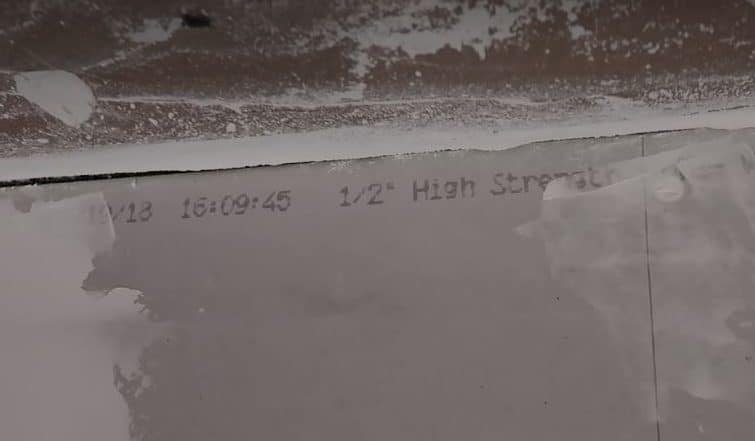
Before you start the cleaning process, make sure that you're wearing a dust mask to protect you from inhaling the harmful dust. I recommend the NASUM Reusable 8200 Face Cover for both drywall DIYers and professionals.
Here's how to clean up drywall dust:
1. Open all the windows in your house
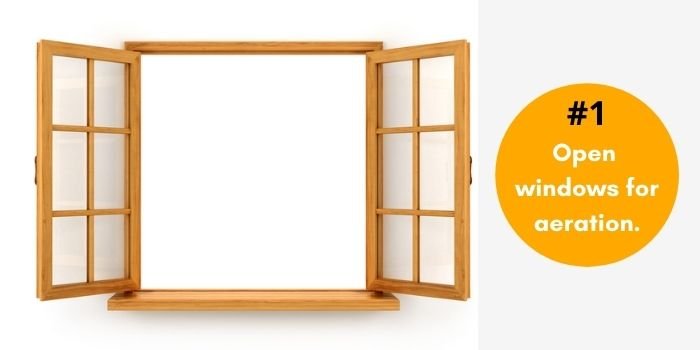
Open the windows and doors in your house to increase ventilation and allow fresh air into the house. Also, ensure that the all the vents, heating, and air conditioning systems are switched off.
This will keep the least amount of drywall dust circulating in the house while you clean it up.
Important : Wear a dust mask or a respirator to avoid inhaling the harmful drywall dust that might get kicked up in the air during the cleaning process.
2. Place a fan at the window pointing outside

Since you're going to sweep some of the dust into piles and collect it, some dust will spread into the air. Placing a fan at the window and setting it to face outside is a great way to direct most of that dust outside. (A good portable fan such as the Lasko 20″ High Velocity Quick Mount Fan is great for this kind of job.)
This step will be more efficient if you could open two or more windows, and if possible, you can put a fan in each. But if you don't have many fans in your house, the open windows would still work.
3. Sweep and remove the bulk of the drywall dust
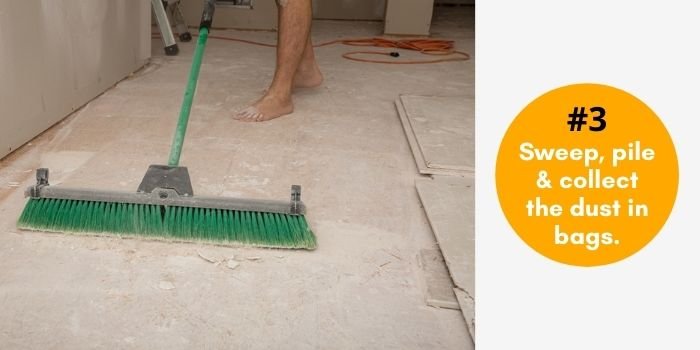
Sweep most of the drywall dust into a pile using a broom and collect it in dust bags using a dust pan. You might want to spray a water mist onto the dust to make it less airborne.
Keep in mind that you'll not be able to get all the dust this way, but you will get most of it. Collect the drywall dust in a garbage bag or pail, then wait for the it to settle for about 15 minutes before proceeding to the next step.
4. Vacuum the floor and other surfaces
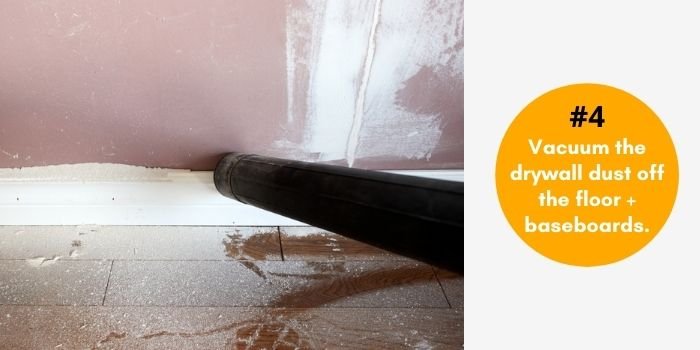
Use a good vacuum for drywall dust with a brush attachment and vacuum from top to bottom, left to right, and move gradually because drywall dust usually clings to walls.
If you sprinkled water onto the dust, you might want to use a strong dry/wet shop vac to clean up the drywall dust without clogging the HEPA filters.
5. Clean the floor with mop and water

After running your shop vac on the floor, the final step is cleaning with a damp cloth or a wet mop – but according to the type of flooring or surface you have. For example, use a microfiber cloth if you're cleaning a hardwood flooring. For a concrete flooring in your garage, use the normal wet mop to clean drywall dust residue.
The damp cloth will easily pick up the dust residue, and you will also not have to stress about it turning into mud. Use the damp cloth to wipe the drywall dust from rough surfaces such as masonry and tile grout.
6. Ventilate the room
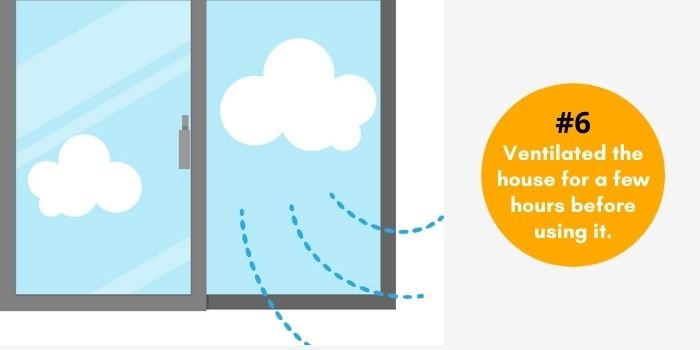
The last step is to ventilate the room adequately before using it. Also, check to make sure no new dust particles have settled onto other surfaces in the house before using it.
Note : If you don't wear a mask or a respirator and are exposed to drywall dust frequently and for an extended period of time, you might develop long-term respiratory problems.
Is it OK to vacuum drywall dust?
You can vacuum drywall dust but not using a regular household vacuum cleaner. It is recommended to use a good shop vac to clean up fine drywall dust, or make sure you fit your regular vacuum with a heavy duty HEPA filter to clean up drywall dust effectively.
The problem with a regular vacuum cleaner is that when you use it to get rid of the fine dust, the bags and filters get clogged quickly, making the vacuum spew dust back into the air.
Dust that fills up the air in your house can lead to respiratory problems, especially if you are not wearing a dust mask.
Your machine will also overheat when collecting fine drywall dust and can easily get damaged.
Drywall Dust on Concrete Floors
If you're working with sheetrock with its dust falling on the concrete floor, it is best to keep the floor a little wet to trap the dust easily. Concrete floors don't scratch easily, so you'll be able to clean up drywall dust by scraping up the mud from the floor with a trowel.
Apart from the trowel, you'll need some water in a spray bottle, a sponge and a piece of cloth or microfiber pad.
Here's the best way to clean up drywall dust from concrete:
Scrape up excess drywall mud from the concrete floor using a trowel, then spray some water on the dirty spots. Scrub the floor with a sponge, adding more water to any stubborn drywall dust spots and repeating the process. Wet-mop the floor using a rug and keep your house well ventilated.
Alternatively, if the sheetrock dust isn't much, vacuum it off the floor using a dry-wet shop vac with a brush attachment. Mop the floor with a wet microfiber pad to lift off any particles of drywall compound that remain on the concrete.
Drywall Dust in Carpet
Carpets can absorb dust that can become very difficult to clean up. If for some reason sheetrock dust got its way into your carpet, you might want to rent a carpet cleaning machine to be able to get rid of it effectively.
Here's how to clean up drywall dust from carpet:
- Dampen the carpet with clear water.
- Run a carpet cleaning machine in small sections.
- Repeat the process to remove all the drywall dust particles from carpet fibers.
- Allow the carpet flooring to dry completely before using the room.
If you're working on a home improvement project, you might want to remove the carpet first to prevent it from absorbing too much drywall dust. Alternatively, cover it with heavy duty plastic sheeting held down on the edges using duct tape. Once you're done, simply fold away the plastic sheeting with the drywall dust and dispose of it safely.
Drywall on Doors, Windows and Ceilings
Drywall dust goes airborne very easily and can settle on doors, windows, ceilings, and inside grout lines on your floor tiles. Cleaning the compound and dust off these surfaces depends on the material.
- Doors: For doors, wipe the dust off the surface with a damp cloth then allow them to dry. Wipe with a clean piece of microfiber cloth to remove any streaks or lines left on your doors.
- Windows: Most windows have glass panes, so gently wipe them with soapy water and a soft microfiber cloth. Rinse with clean water then finally wipe them with WD40 to remove any streak marks.
- Ceilings: If your ceiling is made of sheetrock, do not sprinkle water on it. Simply dry-wipe it or use a brush attachment with a long hose on your vacuum to clean up the drywall dust from the ceiling.
Use a Dust-free Drywall Sander to Prevent Dust
If you frequently deal with drywall dust, or work in such an environment, you might want to invest in the right equipment that will help reduce the amount of drywall dust released into the air. Dust-free sanders are a great example of tools you can start using to prevent exposure to such construction dust.
Here are some of the best dustless tools for drywall applications:
- Dust bubble drill- this drill enables you to drill without dust.
- Abranet ace HD film
- HYDE dust-free sponge sander- this one works best on flat surfaces including as wood.
- Abranet Max Sponge – this is a net that is suited for the wood industry as it is substantially dust-free.
Apart from dust-free sanders, another option I found to work great is wet-sanding drywall sheets. It goes a long way in preventing dust from contaminating air in the house. All you need is to add a wet-sanding attachment to your drywall sander and you'll be able to get rid of the drywall dust easily.
Using the correct tools goes a long way in reducing the amount of work especially during the clean-up stage.
Is Drywall Dust Dangerous and Flammable
When in small amounts, drywall dust is not exactly toxic to the body. This means that it will not cause long-term diseases. However, you should know that it can irritate some parts of the body, such as the throat. This is because drywall dust has a chemical compound known as gypsum.
Gypsum is non-flammable- this means that generally, drywall dust cannot catch fire easily.
Gypsum has the same effects as chlorine in swimming pools, as they have approximately similar pH of 7.7. This is why when drywall dust comes into contact with your eyes, you may feel irritation for a short while.
If you don't wear a mask or a respirator and are exposed to drywall dust frequently and for an extended period of time, you might develop long term health problems.
Consult with your doctor if you think you're exposed to drywall dust for prolonged periods.
READ MORE: How to Clean Up Fiberglass Dust Safely
How To Clean Spackle Dust
Source: https://airlucent.com/clean-drywall-dust/
Posted by: clementexquided.blogspot.com

0 Response to "How To Clean Spackle Dust"
Post a Comment